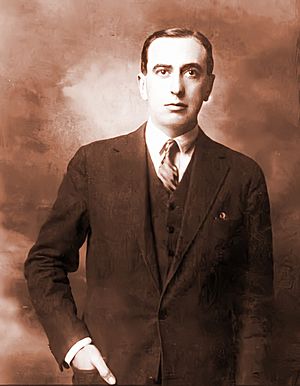Vicente Huidobro facts for kids
Quick facts for kids
Vicente García-Huidobro
|
|
|---|---|

Vicente Huidobro
|
|
| Born | Vicente García-Huidobro Fernández January 10, 1893 Santiago, Chile |
| Died | January 2, 1948 (aged 54) Cartagena, Chile |
| Resting place | Cartagena |
| Occupation | Poet |
| Language | Spanish |
| Nationality | Chilean |
| Education | Colegio San Ignacio |
| Alma mater | Universidad de Chile |
| Period | Twentieth Century |
| Genre | Poetry |
| Literary movement | Creacionismo |
| Notable works | Altazor |
| Notable awards | Municipality of Santiago Prize ("El poliedro y el mar"). 1963 Municipality of Santiago Prize ("Poesía entera"). 1988 |
| Spouse | Manuela Portales Bello (1912), Ximena Amunátegui, Raquel Señoret |
| Children | 5 |
| Relatives | María Luisa Fernández (mother) |
| Signature | |
 |
|
Vicente García-Huidobro Fernández (January 10, 1893 – January 2, 1948) was a famous Chilean poet. He came from a well-known family in Chile. Vicente was a leader in new ways of writing poetry. He created a special style called Creacionismo, which means "Creationism." In this style, poets try to create new worlds with their words, instead of just describing the real world.
Contents
Vicente Huidobro: A Creative Poet
Early Life and First Poems
Vicente Huidobro was born in Santiago, Chile, into a wealthy family. He spent his first years in Europe, learning from French and English teachers. When his family returned to Chile, he went to a Jesuit school called Colegio San Ignacio.
In 1910, he studied literature at the University of Chile. He learned a lot about poetry from his mother, María Luisa Fernández, who was also a poet. She often held gatherings at their home where people talked about literature. In 1912, his mother helped him publish his first magazine, "Musa Joven" (Young Muse).
In 1911, Vicente published his first book, Ecos del alma (Echoes of the Soul). The next year, he got married to Manuela Portales Bello. In 1913, he published Canciones en la noche (Songs in the Night). This book included "Triángulo armónico" ("Harmonic Triangle"), which was his first calligram. A calligram is a poem where the words are arranged to form a picture.
In 1914, he gave a talk called Non serviam. In this talk, he shared his ideas about how poetry should be. He also started signing his works as Vicente Huidobro.
Moving to Europe
In 1916, Huidobro traveled to Buenos Aires, Argentina. There, he started to develop his idea of "Creationism." He also published a book of poems called "El espejo de agua" (The Mirror of Water).
Later in 1916, he moved to Europe with his family. He settled in Paris, which was a center for new art and ideas. In Paris, Huidobro met many famous artists and writers. These included Pablo Picasso, Juan Gris, Amedeo Modigliani, and Paul Éluard. He worked with them on new art styles.
In 1917, he wrote for a magazine called Nord-Sud. He also published Horizon carré, which had poems from "El espejo de agua" translated into French.
In 1918, Huidobro visited Madrid many times. He shared his "Creationism" ideas with Spanish artists. He also helped start a literary movement called Ultraísmo. He worked with Tristan Tzara on his Dadaist magazine.
In 1919, he started writing his most famous work, Altazor. He also became interested in subjects like astrology and ancient Kabbalah.
While in Paris, he worked for several magazines, including L' Esprit Nóuveau. He also wrote for Spanish magazines like "Grecia" and "Ultra."

Altazor and Creationism
In 1921, Huidobro started his own international art magazine called Creación (Creation) in Madrid. It showed art from famous painters like Georges Braque and Pablo Picasso. He also gave a famous talk called La Poesía (Poetry).
The next year, Huidobro shared his "Pure Creation" theory in Paris, Berlin, and Stockholm. He also had an art show in Paris called "Painted poems."
In 1923, he wrote "Finis Britannia," which was a criticism of the British empire. This caused some trouble for him.
Huidobro continued his artistic work in Europe. He published "Manifeste peut-être" (Maybe Manifesto). He also met the Spanish writer Miguel de Unamuno.
In 1925, he returned to Chile. He started a political newspaper called "Acción. Diario de Purificación Nacional." In this paper, he wrote about problems in the government. Because of this, the newspaper was shut down. He then started another newspaper called "La reforma" (Reform).
In 1927, he traveled to New York. There, he met famous actors like Charlie Chaplin. He also wrote a song for the aviator Charles Lindbergh called "Canto a Lindbergh."
He returned to Europe in the late 1920s. He continued working on Altazor and other books. He also found out he was an heir to a noble title, the Marquisate of Casa Real. He joined the Mandrágora, a Chilean group of artists who explored new ideas.
In 1931, he went back to Madrid to publish Altazor. He also became friends with the Uruguayan painter Joaquín Torres García.
Back to Chile
Huidobro returned to Chile in 1932 because of the Great Depression. In Chile, he published "Gilles de Raíz."
In 1933, he joined the Communist Party of Chile. He wrote an article suggesting that Bolivia, Chile, Paraguay, and Uruguay should form one united republic.
In 1934, he wrote movie reviews for magazines in Santiago. He also published a novel called "Papá o el diario de Alicia Mir" (Father, or the diary of Alicia Mir) and a play called "En la Luna" (In the Moon).
In 1936, he signed the "Dimensionist Manifesto" with artists like Pablo Picasso and Vasily Kandinsky.
In 1937, he was in Spain supporting the republican side during the Spanish Civil War.
Back in Chile, he published a poem called "Fuera de aquí" (Out of Here) against Italian fascism. In 1938, his mother passed away. He also helped create the Chilean surrealist group La Mandrágora. Their first meetings were held at his home.
Last Years
In 1942, Huidobro published new editions of his books "Temblor de cielo" and "Mio Cid Campeador" in Santiago.
In 1944, he created his last magazine, "Actual." He traveled to Europe again in 1945 as a reporter for “La Voz de América." He entered Berlin with the Allies as a war correspondent. After the war, he returned to Santiago with his third wife, Raquel Señoret.
In 1946, he settled in Cartagena, a town by the sea in Chile. He published a new edition of "Trois Nouvelles Exemplaires."
The next year, he had a stroke. He passed away on January 2, 1948, at his home in Cartagena. He was buried on a hill facing the sea, as he wished. His daughter Manuela and Eduardo Anguita wrote his epitaph, which says: "Here lies the poet Vicente Huidobro / Open the tomb / At the bottom you can see the sea."
Vicente Huidobro wrote over thirty books of poetry and stories. Many of his works were published after he died.
Vicente Huidobro Museum and Foundation
The Vicente Huidobro Foundation was started in 1990. Its goal is to protect and share the poet's works. The foundation has a research center and archives that are open to students and the public.
On April 6, 2013, Huidobro's house in Cartagena became a museum. The museum has six rooms and shows his manuscripts, letters, first editions of his books, photographs, and his collection of African art.
Tributes to Vicente Huidobro
On January 10, 2020, Google honored Vicente Huidobro on his 127th birthday with a special Google Doodle.
The book Yo-Yo Boing! (1998) by Puerto Rican poet Giannina Braschi talks about important poets from Spain and Latin America, including Huidobro.
Chile has also printed several postage stamps with pictures of Vicente Huidobro, in 1986 and 1993.
See also
 In Spanish: Vicente Huidobro para niños
In Spanish: Vicente Huidobro para niños


